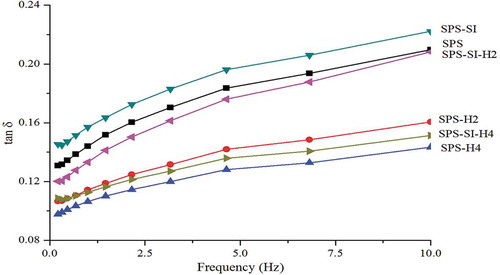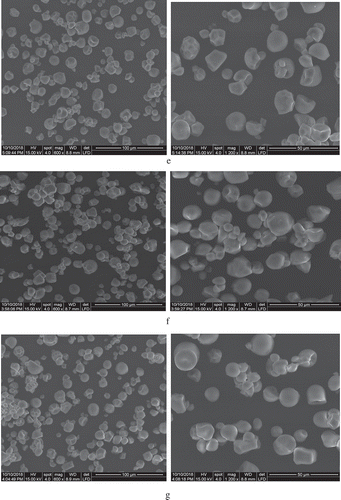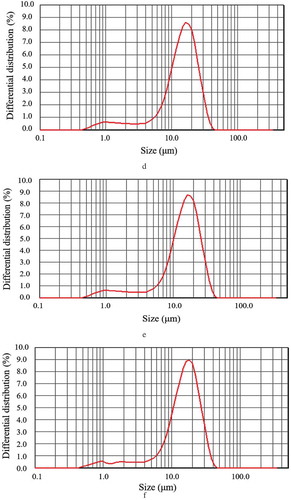ABSTRACT
Sweet potato starch (SPS) was modified by dry heat and short-chain inulin (SI). The influences on physiochemical properties of SPS were explored. Subsequently, the changes in structural characteristics were analyzed. Dry heating made the viscosity parameters increase, pasting temperature and ΔH value reduce, and raised the texture parameters except cohesiveness of SPS. Dry heating with SI remarkably reduced BD and SB of SPS than those of the dry heated samples without SI. Both To and Tc of the dry heated SPS-SI mixture were lower than those of the native SPS. Dry heating with SI improved solid-like characteristics of SPS pastes, and resulted in the increase of the larger particle size of SPS. Adhesive matters could be found on the surface of dry heated SPS-SI mixture. The degree of crystallinity decreased, while the crystallinity type remained unchanged after dry heat treatment with SI.
RESUMEN
En el presente estudio se modificó almidón de batata (SPS) mediante la aplicación de calor seco e inulina de cadena corta (SI) con el fin de determinar cómo este procedimiento influye en sus propiedades fisicoquímicas. Posteriormente, se analizaron los cambios registrados en sus características estructurales. Se constató que el calentamiento en seco produjo el aumento de los parámetros de viscosidad y de los parámetros de textura, excepto la cohesión de SPS, mientras que la temperatura de pegado y el valor de ΔH se redujeron. La comparación de las muestras calentadas en seco con y sin SI mostró que en las primeras, con SI, se redujo notablemente el BD y SB de SPS. Tanto To como Tc de la mezcla SPS-SI calentada en seco fueron más bajas que las del SPS nativo. El calentamiento en seco con SI mejoró las características de tipo sólido de las pastas de SPS, dando como resultado el aumento del tamaño de la partícula más grande de SPS. Asimismo, en la superficie de la mezcla de SPS-SI calentada en seco se encontraron materiales adhesivos. Después del tratamiento térmico en seco con SI el grado de cristalinidad disminuyó y el tipo de cristalinidad permaneció sin cambios.
1. Introduction
Sweet potato (Ipomoea batatas Lam), cultivated in many countries, is ample food material and contains 50% ~80% starch (Tian, Rickard, & Blanshard, Citation2010). Sweet potato starch (SPS) could be used in steamed bread, noodles, cookies, and so on (Monthe et al., Citation2019; Wang et al., Citation2018; Yadav, Yadav, Kumari, & Khatkar, Citation2014; Zhu & Sun, Citation2019). However, the utilization of native starch is limited for its imperfect nature, such as instability of paste, intolerance of shear, and easy retrogradation (Hoover, Citation2001; Hung & Morita, Citation2005; Sun, Si, Xiong, & Chu, Citation2013). To overcome these deficiencies, the modification methods including chemical, physical, and enzymatic method have been explored to modify the starch (Gou et al., Citation2019; Guo, Tao, Cui, & Janaswamy, Citation2019; Lee & Yoo, Citation2011; Zhou, Zhang, Chen, & Chen, Citation2017). Recently, there is a growing interest in the physical modification as it is a green manufacture process without chemical contamination (Oh et al., Citation2018a).
Dry heating treatment is one of the physical modification methods, and has received a great deal of researchers’ attention due to its safety and simplicity. Dry heat treatment was usually carried out under 110–150°C for 1–4 h, and the moisture content of starch was less than 10% (Hoover, Citation2001). Dry heat treatment could change the solubility, swelling ability, viscosity, gelatinization, and rheology (Gou et al., Citation2019; Gul, Riar, Bala, & Sibian, Citation2014; Sun, Gong, Li, & Xiong, Citation2014), and affect the structure of starch granules (Lim, Han, Bemiller, & Lim, Citation2006). Besides dry heat treatment, non-starch hydrocolloids mixed with starch have been reported to enhance the properties of native starch (Charoenrein, Tatirat, Rengsutthi, & Thongngam, Citation2011; Chen, Tian, et al., Citation2017). Lim, Han, Lim, and BeMiller (Citation2002) reported that dry heat combined with carboxymethyl cellulose (CMC) could increase the paste viscosity parameters of waxy maize starch, but decrease those of potato starch (Lim et al., Citation2002). While, Sun et al. (Citation2013) found that dry heat treatment with CMC decreased the paste viscosity parameters of corn starch, but raised those of potato starch. According to Gul et al. (Citation2014), dry heating with CMC or sodium alginate enhanced the gelatinization temperature of water chestnut starch. Additionally, high amylose rice treated with the dry heating and xanthan had the highest gel strength and peak viscosity (Oh, Bae, & Lee, Citation2018b). Clearly, dry heating with non-starch hydrocolloids could be used to modify the physicochemical characteristics of starch.
Inulin is a linear polysaccharide and composed of D-furan fructose units (Li, Ma, & Liu, Citation2019; Luo et al., Citation2017). Based on the degree of polymerization (DP), inulin is classified as short-chain inulin (SI, DP ≤10), middle-chain inulin (MCI, DP 2–60), and long-chain inulin (LCI, DP ≥ 23) (Luo et al., Citation2017). Inulin with different DP could influence the pasting, rheological, and thermal properties of starch in varying degrees (Kou et al., Citation2018; Krystyjan, Ciesielski, Khachatryan, Sikora, & Tomasik, Citation2015; Luo et al., Citation2017; Wang, Wan, Liu, Xia, & Ding, Citation2019; Ye et al., Citation2018). Luo et al. (Citation2017) reported that inulin with low-DP influenced wheat starch retrogradation more effectively than inulin with high-DP. Ye et al. (Citation2018) found that inulin with lower DP had a better influence on the reduction of rice starch gel syneresis.
Although the effect of inulin on the pasting, rheology, and syneresis characteristic of starch had been studied, little attention has been paid to the physical properties of dry-heat-treated starch combined with inulin. Accordingly, the present study was carried out to investigate the effects of dry heating with and without short-chain inulin (SI) on the pasting, thermal, rheological, and textural properties of SPS. Additionally, the changes of granular structure of SPS were explored.
2. Materials and methods
2.1. Materials
Sweet potato starch (SPS) was purchased from Shanghai Saiwengfu Agricultural Development Co., LTD., Shanghai, China. It contained 86.76% total starch and 9.43% moisture. Short-chain inulin (SI) (DP ≤ 10, inulin content ≥90%) was purchased from Cosucra, Belgium.
2.2. Modification of SPS
Modification of SPS, showed in , was carried out according to Lim et al. (Citation2002) with minor modifications. 2.5 g (db) of SI was slowly added to distilled water (90 mL), and stirred using a magnetic stirrer. And then, 47.5 g (db) of SPS was dispersed into the SI solution. After being stirred for 30 min at 25°C, the dispersions were transferred to a glass dish and dried in a convection oven at 45°C until the moisture content reached <10%. The SPS-SI mixture was heated in an electric oven for 0, 2, 4 h at 130°C, respectively. SPS itself was dry heated under the identical conditions.
Table 1. Treatments for modification of SPS with SI and dry heating.
Tabla 1. Tratamientos para la modificación de SPS con SI y calentamiento en seco
2.3. Pasting characteristics
Pasting characteristics of native and modified SPS were investigated using rapid viscosity analyzer (RVA 4500, Sweden) according to the method of Wan et al. (Citation2017). SPS sample (3.0 g) was dispersed in 25 mL of distilled water, and mixed with each other. The slurry of native and modified SPS was heated from 50°C to 95°C in 7.5 min, held at 95°C for 5 min, then cooled to 50°C in 7.5 min, maintained at 50°C for 2 min. The pasting parameters were recorded. All tests were replicated three times.
2.4. Thermal properties
Thermal properties of the samples were measured using a differential scanning calorimeter (DSC) (Q2000, TA instrument, New Castle. DE, USA). Starch samples (3 mg, db) and distilled water (7.5 μL) were transferred to an aluminum pan. The pan was hermetically sealed and equilibrated in the refrigerator for 24 h at 4°C. After being loaded on the DSC, the pans were held for 1 min at 20°C, and then heated from 25°C to 100°C at the rate of 10°C/min. An empty aluminum pan was used as the reference, and nitrogen was used as the carrier gas with the flow of 20 mL/min.
2.5. Texture analysis
After the RVA analysis, the resulting pastes in the RVA canister without plastic paddle were cooled to ambient temperature and covered by fresh-keeping film. The film was removed after being stored for 24 h at 4°C. And then, the gel of native and modified SPS was taken out, and placed on the test plate to be analyzed by using a texture analyzer (TA-XT2i, Stable Micro System, England) with a P/50 probe. The speed of both before and after the test was 1 mm/s, and the test speed was 4 mm/s. And the force was 10 g. The textural parameters were recorded.
2.6. Dynamic rheological properties
Rheological properties were analyzed using a rheometer (Haake Mars 60, Germany) according to the method reported by Zhang, Wang, Li, Sun, and Liu (Citation2019). 3 g of native or modified SPS was dissolved in 50 g of distilled water. The suspension was agitated for 20 min at 20 oC. Subsequently, it was stirred in water bath for 30 min at 95°C. The pastes were loaded on the plate after being cooled to 25 oC. The strain was 1%, and the frequency was in the range of 0.1–10 Hz. Storage modulus (G’), loss modulus (G”), and the tan δ (G”/G’) of the samples were obtained.
2.7. Granule size analysis
The granule sizes of native and modified SPS were analyzed by a laser particle size analyzer (BT-9300H, Dandong Better Ltd., Dandong, China). The distilled water was used as a solvent, and its flow velocity was 60 mL/s. Three replicates per sample were analyzed.
2.8. Morphological properties
Morphology of native and modified SPS granule was analyzed using a scanning electron microscopy (Quanta 200 SEM, FEI, USA). The double-sided active carbon tapes were used to mount the samples on SEM stubs. The accelerating voltage was 15 kV.
2.9. X-ray diffraction analysis
The X-ray pattern of native and modified SPS was measured using a diffractometer (D8 Advance A25, Germany). The diffractometer was operated under voltage of 40 kV and current of 40 mA. And the diffraction angle (2θ) was in the range of 5–50°. 0.02° of step size and 3°/min of scanning speed was used.
2.10. Statistical analysis
The experimental data were expressed as means ± standard deviations. One-way analysis of variance and least significant difference test were analyzed by using SPSS 19.0 (SPSS Incorporated, Chicago, USA). Differences were considered significant at level of 0.05.
3. Results and discussion
3.1. Effect of dry heating with SI on paste properties of SPS
The past parameters and curve of SPS and dry heated SPS with and without SI are shown in and , respectively. The addition of SI decreased the peak viscosity (PV), final viscosity (FV), breakdown viscosity (BD), and setback viscosity (SB) of SPS. The decrease of SB indicated that SI could delay the retrogradation and improve the freezing stability of SPS. The BD reduced from 1072 cP in native SPS to 915 cP in SPS-SI mixture, which indicated that SI could enhance the thermal stability of SPS (BeMiller, Citation2011). Similar results were found when wheat, potato, and rice starch were blended with inulin (Wang et al., Citation2019; Witczak, Witczak, & Ziobro, Citation2014; Ye et al., Citation2018). Additionally, SI slightly increased the pasting temperature (GT) of SPS, which may be related to the high water-binding capacity of SI. Similar result was reported by Wang et al. (Citation2019), who found that rice starch GT rose after being blended with SI.
Table 2. Paste parameters of SPS and dry-heat-treated SPS with and without SI.
Tabla 2. Parámetros de pegado de SPS y SPS tratado con calor seco, con y sin SI
Figure 1. Pasting curves of SPS and dry-heat-treated SPS with and without SI.
Figura 1. Curvas de pegado de SPS y SPS tratado con calor seco, con y sin SI
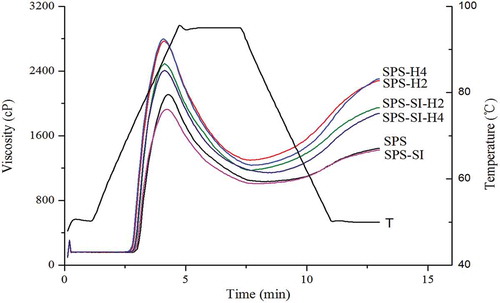
Dry heat treatment without SI resulted in higher viscosity indices, including FV, PV, BD and SB of SPS. With the increase in heating time, both SB and BD increased significantly (p < 0.05), while PV and FV increased slightly (p > 0.05). The increase of BD indicated that dry heat treatment reduced the shear resistance and thermal stability of SPS. Similar results were in agreement with previous findings (Falade & Onyeoziri, Citation2012; Si, Citation2012). Si (Citation2012) found that dry heat treatment resulted in the increase of PV, FV, BD and SB of potato starch. The increase of starch paste viscosity may be related to the loose structure resulting from the rearrangement of amorphous zone and the unwinding of double helix structure of starch during dry heat treatment (Bhandari & Singhal, Citation2002; Li et al., Citation2013). The GT of dry heated SPS were lower than those of native starch, and decreased remarkably with heating time prolonged (p < 0.05) (). This might be due to the disintegration of granular structure by dry heating.
Compared to the dry-heat treatment without SI, dry heating with SI remarkably reduced PV, FV, BD, and SB of SPS. As heating time prolonged, PV, FV, and SB decreased slightly (p > 0.05), GT decreased significantly (p < 0.05), while BD increased slightly (p > 0.05) (). Being dry heated for 4 h, BD and SB of SPS-SI were 1312 cP and 766 cP, respectively, which was significantly lower than those of the only dry-heat SPS (p < 0.05). These indicated that dry heating with SI could improve the thermal stability and retrogradation of SPS. Similar results were obtained when potato starch was modified by dry heating with sodium alginate (Sun et al., Citation2013).
3.2. Effect of dry heating with SI on thermal properties of SPS gel
Thermal parameters and curve of SPS and dry heated SPS with and without SI are shown in and . Compared to the native SPS, SI slightly raised the transition temperatures (To-onset gelatinization temperature, Tp-peak gelatinization temperature, Tc-end point temperature) of SPS (p > 0.05), while significantly reduced the gelatinization endothermic (ΔH) value of SPS (p < 0.05) (). High water-holding capacity of inulin made starch granules not easy to expand, so that delayed the gelatinization of starch. Similar results were founded when rice starch and maize distarch phosphateinulin were mixed with inulin (Luo et al., Citation2016; Wang et al., Citation2019). While Witczak et al. (Citation2014) found that the addition of short-chain inulin had no effect on To of potato starch, but increased Tp, Tc and ΔH value. The different result may be due to the different types of starch.
Table 3. Thermal parameters of SPS and dry-heat-treated SPS with and without SI.
Tabla 3. Parámetros térmicos de SPS y SPS tratado con calor seco, con y sin SI
Figure 2. DSC thermographs of SPS and dry-heat-treated SPS with and without SI.
Figura 2. Termógrafos DSC de SPS y SPS tratado con calor seco, con y sin SI

Compared to the native SPS, the dry-heat treated SPS with and without SI showed lower To and Tc. Being dry heated for 4 h, both To and Tc of SPS without SI had the highest decline of 1.82°C and 1.17°C, respectively. Additionally, there was an obvious reduction in ΔH value between SPS and dry-heat treated samples. ΔH value decreased as the reaction time increased. SPS with SI showed a higher decrease in ΔH from 2.18 J/g (SPS) to 1.61 J/g (SPS-SI-H2), and 1.42 J/g (SPS-SI-H4), respectively. The decrease of ΔH value during dry heat treatment may be due to the decrease of the amount of double helical order. Similar results had been reported when potato, rice, and cassava starch were treated with dry heating (Chandanasree et al., Citation2016; Gul et al., Citation2014; Liu, Hao, Chen, & Gao, Citation2019; Qiu et al., Citation2015; Si, Citation2012; Sun et al., Citation2013). Chandanasree, Gul, and Riar (Citation2016) reported that the dry heat treatment resulted in the decrease of To, Tp, Tc and ΔH in starch from Cassava (Manihot esculenta). Liu et al. (Citation2019) found that dry heating treatment reduced the GT and decreased ΔH value of waxy potato starch. Si (Citation2012) reported that dry heat treatment significantly reduced the To, Tp and Tc of potato starch and made ΔH value decrease. Sun et al. (Citation2013) reported that after being dry-heat treatment, To, Tp and Tc of potato starch with sodium alginate, CMC and xanthan decreased significantly, and ΔH value of dry heated potato starches reduced, too. Additionally, ΔH value of dry-heat-treated samples decreased as the reaction time prolonged (). Obviously, dry heat treatment with SI could affect the thermal properties of SPS.
It was interesting that the To, Tp and Tc of dry-heat treated SPS with SI was higher than those of heated samples without SI at the same treatment time. These results were in agreement with the data summarized in .
3.3. Effect of dry heating with SI on texture characteristics of SPS gel
With the addition of SI, the hardness, cohesiveness, gumminess, and chewiness of SPS-SI gel reduced, while both springiness and resilience rose slightly (p > 0.05) (). These results were similar to the previous findings (Charoenrein et al., Citation2011; Diao, Citation2015; Luo et al., Citation2016). Diao (Citation2015) reported the texture of rice starch gel became soft with the addition of inulin, and Luo et al. (Citation2016) found that the resilience of maize distarch phosphate increased when SI was added, while it was not significantly different from that of the control.
Table 4. Textural parameters of gel prepared by SPS and dry-heat-treated SPS with or without SI.
Tabla 4. Parámetros texturales del gel preparado por SPS y SPS tratado con calor seco, con o sin SI
Compared to the native SPS, the dry-heat treated SPS with and without SI showed increased texture parameters except cohesiveness. Without the addition of SI, the hardness increased to the highest value of 284.3 g in the case of 4 h dry-heat-treated sample (p < 0.05). The springiness value of SPS-SI heated for 4 h was 0.97, which was similar to that of 4 h dry-heated samples without SI. Similar results had been reported when potato starch was treated with dry heating, while the elasticity, resilience, chewiness and cohesiveness of corn starch decreased after 130°C dry heat for 4 h (Si, Citation2012). Si (Citation2012) reported that with the increase of dry-heat time, dry heat with xanthan gum raised the hardness, adhesiveness and chewiness of potato starch. Dry heat with CMC significantly increased the adhesiveness, hardness and chewiness of potato starch, while the elasticity, cohesion and resilience did not change significantly.
When heating time rose from 2 h to 4 h, the gel hardness, springiness, and chewiness of dry-heat treated SPS without SI increased significantly, and gumminess increased slightly, while the cohesiveness and resilience changed barely. It was interesting that the dry-heat treatment with SI slightly increased all the texture parameters of modified SPS except gumminess along with the heating time prolonged. Additionally, both hardness and chewiness of SPS-SI mixture dry heated for 4 h were much lower than those of samples without SI treated at the same time (p < 0.05), while springiness, cohesiveness, gumminess, and resilience changed slightly (p > 0.05).
3.4. Effect of dry heating with SI on rheological characterization of SPS gel
The viscoelastic properties of native SPS and dry heated SPS are presented in . Both storage modulus (G’) and loss modulus (G”) of native SPS and modified SPS were frequency dependency. The magnitudes of G’ and G” rose with the increase of frequency. Additionally, the values of G’ were higher than those of G” within the detected frequency range. These suggested the dry heated SPS with and without SI had the typical rheological behavior of weak gels.
Figure 3. The change in the storage modulus (G’) and loss modulus (G”) of gel prepared by SPS and dry-heat-treated SPS with and without SI with frequency scanning. Close symbols are G’, open symbols are G”.
Figura 3. Cambio en el módulo de almacenamiento (G’) y el módulo de pérdida (G”) del gel preparado por SPS y SPS tratado con calor seco, con y sin SI, con escaneo de frecuencia. Los símbolos cerrados son G’, los símbolos abiertos son G”
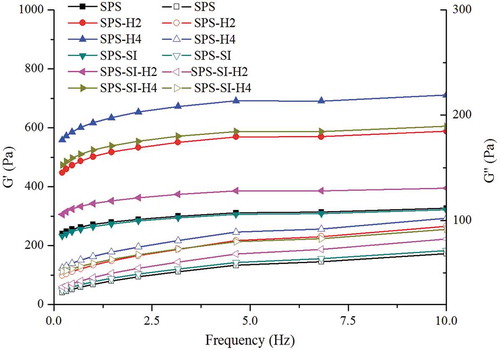
The G’ of SPS-SI mixture without dry heat was slightly lower than that of native SPS gel. Similar result was obtained by Wang et al. (Citation2019). Both G’ and G” of dry-heat treated SPS combined with and without SI were much higher than that of native SPS gel, and increased as dry treatment time prolonged. Additionally, the G’ and G” of only dry-heat-treated SPS exceeded those of dry-heated samples with SI at the same treatment time.
The lower of tan δ was, the solid-like behavior was (Ptaszek & Grzesik, Citation2007). The tan δ of SPS-SI gel without dry-heat was obviously higher than that of native SPS gel (). This result suggested that SI could make SPS gel have the stronger liquid-like behavior, which was in agreement with the results obtained in . Similar results were obtained when inulin was blended with wheat starch and rice starch (Wang et al., Citation2017, Citation2019). Additionally, addition of galactomannan raised the tan δ of acorn starch gel (Kim & Yoo, Citation2011). The tan δ of all the dry-heated SPS samples was lower than that of native SPS gel. Similar result was found with Li et al. (Citation2013), who reported tan δ of waxy rice starch decreased after the dry heat treatment with xanthan. Additionally, the tan δ of the dry-heated SPS samples became much lower with the increase in heating time. These results suggested that the dry heat could strengthen the SPS gel with stronger solid-like behavior. Treated for the same time, the tan δ of SPS without SI was lower than that of samples with SI ().
3.5. Effect of dry heating with SI on microstructure of SPS
SEM images for the native and dry-heat-treated SPS with and without SI were shown in . The native SPS showed round, oval, and polygonal shapes ()). This result was similar to the previous findings (Abegunde, Mu, Chen, & Deng, Citation2013; Das, Singh, Singh, & Riar, Citation2010).
Figure 5. SEM of SPS and dry-heat-treated SPS with and without SI. a, b, c, d, e, f, and g are SEM for SI, SPS, SPS-H2, SPS-H4, SPS-SI, SPS-SI-H2, and SPS-SI-H4, respectively.
Figura 5. SEM de SPS y SPS tratado con calor seco, con y sin SI. a, b, c, d, e, f y g son SEM para SI, SPS, SPS-H2, SPS-H4, SPS-SI, SPS-SI-H2 y SPS-SI-H4, respectivamente
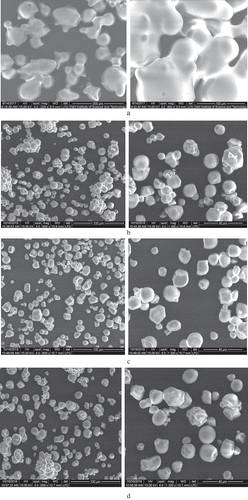
No significant change could be observed after dry heat treatment at 130°C for 2 h ()). However, granules of SPS showed a slight expansion with rough or ruptured surface after dry heat treatment for 4 h. The appearance of the ruptured granules was similar to popcorn ()). These phenomena could be attributed to the high temperature, which could accelerate the movement of starch molecules, and lead to rupturing or collapse and the amylose leaching of SPS.
The granules of SPS-SI expanded after dry heat treatment ()). Adhesive matters could be found on the surface of the particles, which adhered to each other. It may be due to the leached amylose molecules and SI, which surrounded the SPS granules. Similar result was found with Zhang, Zhang, Guo, Chen, and Zheng (Citation2012), who reported that the adhesives on the surface of dry-heat-modified lotus-seed starch-sodium alginate sample could be found.
3.6. Effect of dry heating with SI on the particle size of SPS
The particle size distributions of native and modified SPS are shown in and . As compared with native SPS, both the median diameter and volume average diameter of dry-heat-treated SPS with and without SI became larger, and increased with the heating time prolonged. After being heated at 130°C for 4 h, both the median diameter and volume average diameter of SPS-SI mixture rose to the highest value, which was 15.52 and 15.87 µm, respectively. This indicated that dry heat treatment could make SI interact with starch molecule, resulting in the increase of the median diameter of dry heated SPS. This result was similar to the previous findings. Shen, Zhong, and Ma (Citation2007) reported that the increase of the particle size of dry-heated corn starch with CMC was much obvious than that of starch samples heated without CMC. Zhang (Citation2013) found that mean particle sizes of potato starch modified with chitosan, xanthan and carrageenan by dry heating were much larger than that of native potato starch granules.
Table 5. The granular size distribution of SPS and dry-heat-treated SPS with or without SI.
Tabla 5. Distribución del tamaño granular de SPS y SPS tratado con calor seco, con o sin SI
Figure 6. Differential distribution of granule size of SPS and dry-heat-treated SPS with or without SI. a, b, c, d, e, and f are granular size differential distribution for SPS, SPS-H2, SPS-H4, SPS-SI, SPS-SI-H2, and SPS-SI-H4, respectively.
Figura 6. Distribución diferencial del tamaño de gránulo de SPS y SPS tratado con calor seco, con o sin SI. a, b, c, d, e y f son distribuciones diferenciales del tamaño granular para SPS, SPS-H2, SPS-H4, SPS-SI, SPS-SI-H2 y SPS-SI-H4, respectivamente
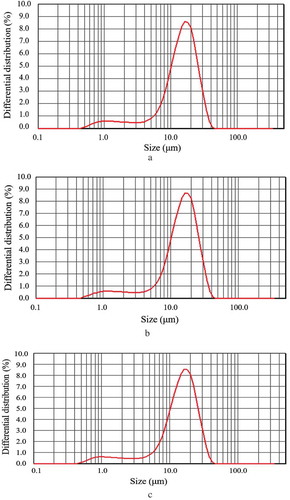
Additionally, dry heat combined with SI resulted in the decrease of small particle size, while the increase of medium and large particle size. Large granules increased from 4.82% of native SPS to 6.03% of SPS treated at 130°C for 4 h. This indicated that dry heat treatment could make SI combine with starch, and SI linked starch granules to form larger aggregates, so that the proportion of large granules in the blends increased. Similar result was found by Chen, Feng, et al. (Citation2017), who reported the volume fraction of big starch particles of SPS starch granules increased with the addition of pectin and the increase of drying time, and reached to the largest value at dry-heat time of 3 h.
3.7. Effect of dry heating with SI on X-ray diffraction of SPS
presents the X-ray diffraction patterns of the native and dry-heat-treated SPS. The native SPS showed A-type pattern with main diffraction peaks at angle 2θ values of 15°, 17°, 18° and 23°. The similar result was reported by Gou et al. (Citation2019). After being dry heated, the X-ray diffraction patterns had no new peaks in the difractograms, and the crystallization type remained A-type (). Similar results had been reported when both rice and corn starches were treated with dry heat (Ji, Yu, Xu, & Zhang, Citation2016; Oh, Bae, & Lee, Citation2018a; Qiu et al., Citation2015). These results may indicate that the changes in properties during dry heating mainly occurred in the amorphous region of starch granules (Gou et al., Citation2019).
Figure 7. X-ray diffraction patterns of SPS and dry-heat-treated SPS with and without SI.
Figura 7. Patrones de difracción de rayos X de SPS y SPS tratado con calor seco, con y sin SI
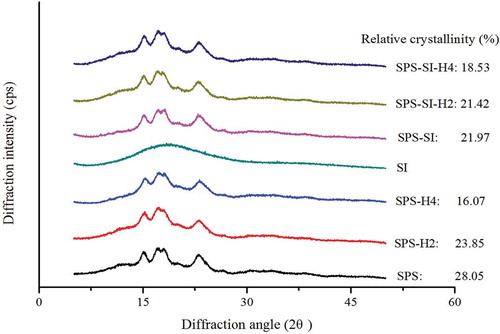
Dry treatment with or without SI decreased the relative crystallinity of SPS. And the relative crystallinity of SPS decreased with longer heating time (). The crystallinity of dry heated SPS without SI decreased to a minimum value (16.07%) after treatment for 4 h, which was lower than that of the native SPS. The relative crystallinity of high amylose rice starch reduced after dry heat treatment at 130 for 1, 2 and 4 h (Oh et al., Citation2018a). The relative crystallinity of proso millet starch decreased after being treated at 130°C for 2 or 4 h, too (Sun et al., Citation2014). While, dry heating treatment increased the crystallinity of waxy rice starch (Li et al., Citation2013). The decreased crystallinity may result from the increase of amorphous region or the degradation of crystalline region during dry heating (Sun et al., Citation2014).
It should be noticed that after being dry heated for 4 h, the relative crystallinity of SPS-SI was 18.53%, which was larger than that of heated SPS without SI (16.07%). This illustrated that, with the addition of SI, the amorphous region of starch granule became more resistant to dry heating. Similar result was obtained by Li et al. (Citation2013).
4. Conclusions
Dry heat treatment with and without SI increased the viscosity indices, and decreased the pasting temperature and ΔH value of SPS. Compared to the dry-heat treatment without SI, dry heating with SI remarkably reduced BD and SB of SPS, which indicated that dry heating with SI could improve the thermal stability and retrogradation of SPS. After dry heating, the G’ of SPS-SI mixture gel was much higher than that of the native SPS, while the tan δ of dry-heated SPS-SI samples showed the downward trend, which suggested that the dry heat treatment with SI could strengthen the SPS gel with stronger solid-like behavior. The dry-heat treatment with SI slightly increased all the texture parameters of modified SPS except gumminess along with the heating time prolonged. SEM showed that after dry heat treatment for 4 h, the granules of SPS expanded slightly with rough or ruptured surface, and adhesive matters could be found on the surface of the SPS-SI particles. Dry heating combined with SI resulted in the decrease of small particle size, while the increase of medium and large particle size. Treated by dry heating with SI, the relative crystallinity of SPS decreased, while the crystallization type remained A-type. In general, dry heating with SI could be used as a simple and efficient method for modification of starch.
Ethical Approval
This article does not contain any studies with human participants or animals performed by any of the authors.
Disclosure statement
All authors declare that there is no conflict of interest.
Additional information
Funding
References
- Abegunde, O. K., Mu, T. H., Chen, J. W., & Deng, F. M. (2013). Physicochemical characterization of sweet potato starches popularly used in Chinese starch industry. Food Hydrocolloids, 33(2), 169–177. doi:10.1016/j.foodhyd.2013.03.005
- BeMiller, J. N. (2011). Pasting, paste, and gel properties of starch-hydrocolloid combinations. Carbohydrate Polymers, 86(2), 386–423. doi:10.1016/j.carbpol.2011.05.064
- Bhandari, P. N., & Singhal, R. S. (2002). Effect of succinylation on the corn and amaranth starch pastes. Carbohydrate Polymer, 48. doi:10.1016/S0144-8617(01)00310-1
- Chandanasree, D., Gul, K., & Riar, C. S. (2016). Effect of hydrocolloids and dry heat modification on physicochemical, thermal, pasting and morphological characteristics of cassava (Manihot esculenta) starch. Food Hydrocolloids, 52:, 175–182. doi:10.1016/j.foodhyd.2015.06.024
- Charoenrein, S., Tatirat, O., Rengsutthi, K., & Thongngam, M. (2011). Effect of konjac glucomannan on syneresis, textural properties and the microstructure of frozen rice starch gels. Carbohydrate Polymers, 83(1), 291–296. doi:10.1016/j.carbpol.2010.07.056
- Chen, L., Tian, Y., Tong, Q., Zhang, Z., & Jin, Z. (2017). Effect of pullulan on the water distribution, microstructure and textural properties of rice starch gels during cold storage. Food Chemistry, 214, 702–709. doi:10.1016/j.foodchem.2016.07.122
- Chen, M., Feng, L., Li, F., Zhang, J., & Li, G. (2017). Synergistic effects of pectin and dry-heat on molecular structure of sweet potato starch. Science and Technology of Food Industry, 38(9), 60–65. Retrieved from: http://www.cnki.net
- Das, A. B., Singh, G., Singh, S., & Riar, C. S. (2010). Effect of acetylation and dual modification on physico-chemical, rheological and morphological characteristics of sweet potato (Ipomoea batatas) starch. Carbohydrate Polymers, 80(3), 725–732. doi:10.1016/j.carbpol.2009.12.018
- Diao, S. C. (2015). Effect of inulin on physicochemical properties of rice starch and the quality of rice-cakes (Master’s thesis). Anhui Agricultural University, Hefei, China. Retrieved from http://www.cnki.net
- Falade, K. O., & Onyeoziri, N. F. (2012). Effects of cultivar and drying method on color, pasting and sensory attributes of instant yam (Dioscorea rotundata) flours. Food & Bioprocess Technology, 5(3), 879–887. doi:10.1007/s11947-010-0383-8
- Gou, M., Wu, H., Saleh, A. S. M., Jing, L., Liu, Y., Zhao, K., & Li, W. (2019). Effects of repeated and continuous dry heat treatments on properties of sweet potato starch. International Journal of Biological Macromolecules, 129, 869–877. doi:10.1016/j.ijbiomac.2019.01.225
- Gul, K., Riar, C. S., Bala, A., & Sibian, M. S. (2014). Effect of ionic gums and dry heating on physicochemical, morphological, thermal and pasting properties of water chestnut starch. LWT-Food Science and Technology, 59(1), 348–355. doi:10.1016/j.lwt.2014.04.060
- Guo, L., Tao, H., Cui, B., & Janaswamy, S. (2019). The effects of sequential enzyme modifications on structural and physicochemical properties of sweet potato starch granules. Food Chemistry, 277, 504–515. doi:10.1016/j.foodchem.2018.11.014
- Hoover, R. (2001). Composition, molecular structure, and physicochemical properties of tuber and root starches: A review. Carbohydrate Polymers, 45, 253–267. doi:10.1016/S0144-8617(00)00260-5
- Hung, P. V., & Morita, N. (2005). Physicochemical properties and enzymatic digestibility of starch from edible canna (Canna edulis) grown in Vietnam. Carbohydrate Polymers, 61, 314–321. doi:10.1016/j.carbpol.2005.04.021
- Ji, Y., Yu, J., Xu, Y., & Zhang, Y. (2016). Impact of dry heating on physicochemical properties of corn starch and lysine mixture. International Journal of Biological Macromolecules, 91, 872–876. doi:10.1016/j.ijbiomac.2016.06.040
- Kim, W. W., & Yoo, B. (2011). Rheological and thermal effects of galactomannan addition to a corn starch paste. LWT-Food Science and Technology, 44(3), 759–764. doi:10.1016/j.lwt.2010.11.009
- Kou, X., Luo, D., Li, Y., Xu, B., Zhang, K., Li, P., & Liu, J. (2018). Effect of inulin with different degree of polymerisation on textural and rheological properties of wheat starch-effect of inulin on gel properties of starch. International Journal of Food Science and Technology, 53(11), 1–10. doi:10.1111/ijfs.2018.53.issue-11
- Krystyjan, M., Ciesielski, W., Khachatryan, G., Sikora, M., & Tomasik, P. (2015). Structure, rheological, textural and thermal properties of potato starch–inulin gels. LWT-Food Science and Technology, 60(1), 131–136. doi:10.1016/j.lwt.2014.07.056
- Lee, H. L., & Yoo, B. (2011). Effect of hydroxypropylation on physical and rheological properties of sweet potato starch. LWT - Food Science and Technology, 44(3), 765–770. doi:10.1016/j.lwt.2010.09.012
- Li, Y., Ma, X., & Liu, X. (2019). Physicochemical and rheological properties of cross-linked inulin with different degree of polymerization. Food Hydrocolloids, 95, 318–325. doi:10.1016/j.foodhyd.2018.11.026
- Li, Y., Zhang, H., Shoemaker, C. F., Xu, Z., Zhu, S., & Zhong, F. (2013). Effect of dry heat treatment with xanthan on waxy rice starch. Carbohydrate Polymers, 92, 1647–1652. doi:10.1016/j.carbpol.2012.11.002
- Lim, H. S., Han, J. A., Bemiller, J. N., & Lim, S. T. (2006). Physical modification of waxy maize starch by dry heating with ionic gums. Journal of Applied Glycoscience, 53(4), 281–286. doi:10.5458/jag.53.281
- Lim, S. T., Han, J. A., Lim, H. S., & BeMiller, J. N. (2002). Modification of starch by dry heating with ionic gums. Cereal Chemistry, 79(5), 601–606. doi:10.1094/CCHEM.2002.79.5.601
- Liu, K., Hao, Y., Chen, Y., & Gao, Q. (2019). Effects of dry heat treatment on the structure and physicochemical properties of waxy potato starch. International Journal of Biological Macromolecules, 132, 1044–1050. doi:10.1016/j.ijbiomac.2019.03.146
- Luo, D., Li, Y., Wu, Y., Xu, B., Li, X., Liu, J., & Zhang, X. (2016). Effect of short-chain inulin on thermodynamic properties of maize distarch phosphate. Food Science, 37(7), 6–10. Retrieved from: http://www.cnki.net
- Luo, D., Li, Y., Xu, B., Ren, G., Li, P., Li, X., & Liu, J. (2017). Effects of inulin with different degree of polymerization on gelatinization and retrogradation of wheat starch. Food Chemistry, 229, 35–43. doi:10.1016/j.foodchem.2017.02.058
- Monthe, O. C., Grosmaire, L., Nguimbou, R. M., Dahdouh, L., Ricci, J., Tran, T., & Ndjouenkeu, R. (2019). Rheological and textural properties of gluten-free doughs and breads based on fermented cassava, sweet potato and sorghum mixed flours. LWT–Food Science and Technology, 101, 575–582. doi:10.1016/j.lwt.2018.11.051
- Oh, I. K., Bae, I. Y., & Lee, H. G. (2018a). Effect of dry heat treatment on physical property and in vitro starch digestibility of high amylose rice starch. International Journal of Biological Macromolecules, 108, 568–575. doi:10.1016/j.ijbiomac.2017.11.180
- Oh, I. K., Bae, I. Y., & Lee, H. G. (2018b). Complexation of high amylose rice starch and hydrocolloid through dry heat treatment: Physical property and in vitro starch digestibility. Journal of Cereal Science, 79, 341–347. doi:10.1016/j.jcs.2017.11.017
- Ptaszek, P., & Grzesik, M. (2007). Viscoelastic properties of maize starch and guar gum gels. Journal of Food Engineering, 82(2), 227–237. doi:10.1016/j.jfoodeng.2007.02.013
- Qiu, C., Li, X., Ji, N., Qin, Y., Sun, Q., & Xiong, L. (2015). Rheological properties and microstructure characterization of normal and waxy corn starch dry heated with soy protein isolate. Food Hydrocolloids, 48, 1–7. doi:10.1016/j.foodhyd.2015.01.030
- Shen, X. R., Zhong, F., & Ma, J. G. (2007). Paste properties of modified starches by dry heating treatment with carboxymethylcellulose sodium. Food & Machinery, 23(3), 20–24. Retrieved from: http://www.cnki.net
- Si, F. M. (2012). Effect of dry heating treatment on structure and properties of starches (Master’s thesis). Qingdao Agricultural University, Qingdao, China. Retrieved from http://www.cnki.net
- Sun, Q., Gong, M., Li, Y., & Xiong, L. (2014). Effect of dry heat treatment on the physicochemical properties and structure of proso millet flour and starch. Carbohydrate Polymers, 110, 128–134. doi:10.1016/j.carbpol.2014.03.090
- Sun, Q., Si, F., Xiong, L., & Chu, L. (2013). Effect of dry heating with ionic gums on physicochemical properties of starch. Food Chemistry, 136, 1421–1425. doi:10.1016/j.foodchem.2012.09.061
- Tian, S. J., Rickard, J. E., & Blanshard, J. M. V. (2010). Physicochemical properties of sweet potato starch. Journal of the Science of Food & Agriculture, 57(4), 459–491. doi:10.1002/jsfa.2740570402
- Wan, J., Zhou, G. H., Luo, S. J., Wang, R. S., Liu, C. M., Zhang, X., & Liu, F. (2017). A study of the effect of amino acids on pasting and short-term retrogradation properties of rice starch based on molecular dynamics simulation. Starch-Stärke, 69, 9–10. doi:10.1002/star.v69.9-10
- Wang, M., Wei, L., Zhu, P., Wang, N., Du, X., & Zhou, Y. (2017). Effect of inulin on thermodynamic and rheological properties of wheat starch paste. Journal of the Chinese Cereals and Oils Association, 32(2), 24–29. Retrieved from: http://www.cnki.net
- Wang, R., Wan, J., Liu, C., Xia, X., & Ding, Y. (2019). Pasting, thermal, and rheological properties of rice starch partially replaced by inulin with different degrees of polymerization. Food Hydrocolloids, 92, 228–232. doi:10.1016/j.foodhyd.2019.02.008
- Wang, Y., Ye, F., Liu, J., Zhou, Y., Lei, L., & Zhao, G. (2018). Rheological nature and dropping performance of sweet potato starch dough as influenced by the binder pastes. Food Hydrocolloids, 85, 39–50. doi:10.1016/j.foodhyd.2018.07.001
- Witczak, T., Witczak, M., & Ziobro, R. (2014). Effect of inulin and pectin on rheological and thermal properties of potato starch paste and gel. Journal of Food Engineering, 124, 72–79. doi:10.1016/j.jfoodeng.2013.10.005
- Yadav, B. S., Yadav, R. B., Kumari, M., & Khatkar, B. S. (2014). Studies on suitability of wheat flour blends with sweet potato, colocasia and water chestnut flours for noodle making. LWT-Food Science and Technology, 57(1), 352–358. doi:10.1016/j.lwt.2013.12.042
- Ye, J., Yang, R., Liu, C., Luo, S., Chen, J., Hu, X., & Wu, J. (2018). Improvement in freeze-thaw stability of rice starch gel by inulin and its mechanism. Food Chemistry, 268, 324–333. doi:10.1016/j.foodchem.2018.06.086
- Zhang, F., Zhang, Y., Guo, Z., Chen, J., & Zheng, B. (2012). The characteristics of lotus seed starch modified by dry heating. Chinese Journal of Tropical Crops, 33(2), 364–369. Retrieved from: http://www.cnki.net
- Zhang, L., Wang, X., Li, S., Sun, J., & Liu, X. (2019). Effect of inulin on the pasting, textural, and rheological properties of sweet potato starch. CyTA -journal of Food, 17(1), 733–743. doi:10.1080/19476337.2019.1645738
- Zhang, M. Y., (2013). Study on potato starch modified by dry heating with hydrocolloids (Master’s thesis). Shaanxi University of Science and Technology, Xi’an, China. Retrieved from http://www.cnki.net
- Zhou, D. N., Zhang, B., Chen, B., & Chen, H. Q. (2017). Effects of oligosaccharides on pasting, thermal and rheological properties of sweet potato starch. Food Chemistry, 230, 516–523. doi:10.1016/j.foodchem.2017.03.088
- Zhu, F., & Sun, J. (2019). Physicochemical and sensory properties of steamed bread fortified with purple sweet potato flour. Food Bioscience, 30. doi:10.1016/j.fbio.2019.04.012

